coolant level FORD MUSTANG 1998 4.G Owners Manual
[x] Cancel search | Manufacturer: FORD, Model Year: 1998, Model line: MUSTANG, Model: FORD MUSTANG 1998 4.GPages: 192, PDF Size: 1.67 MB
Page 11 of 192
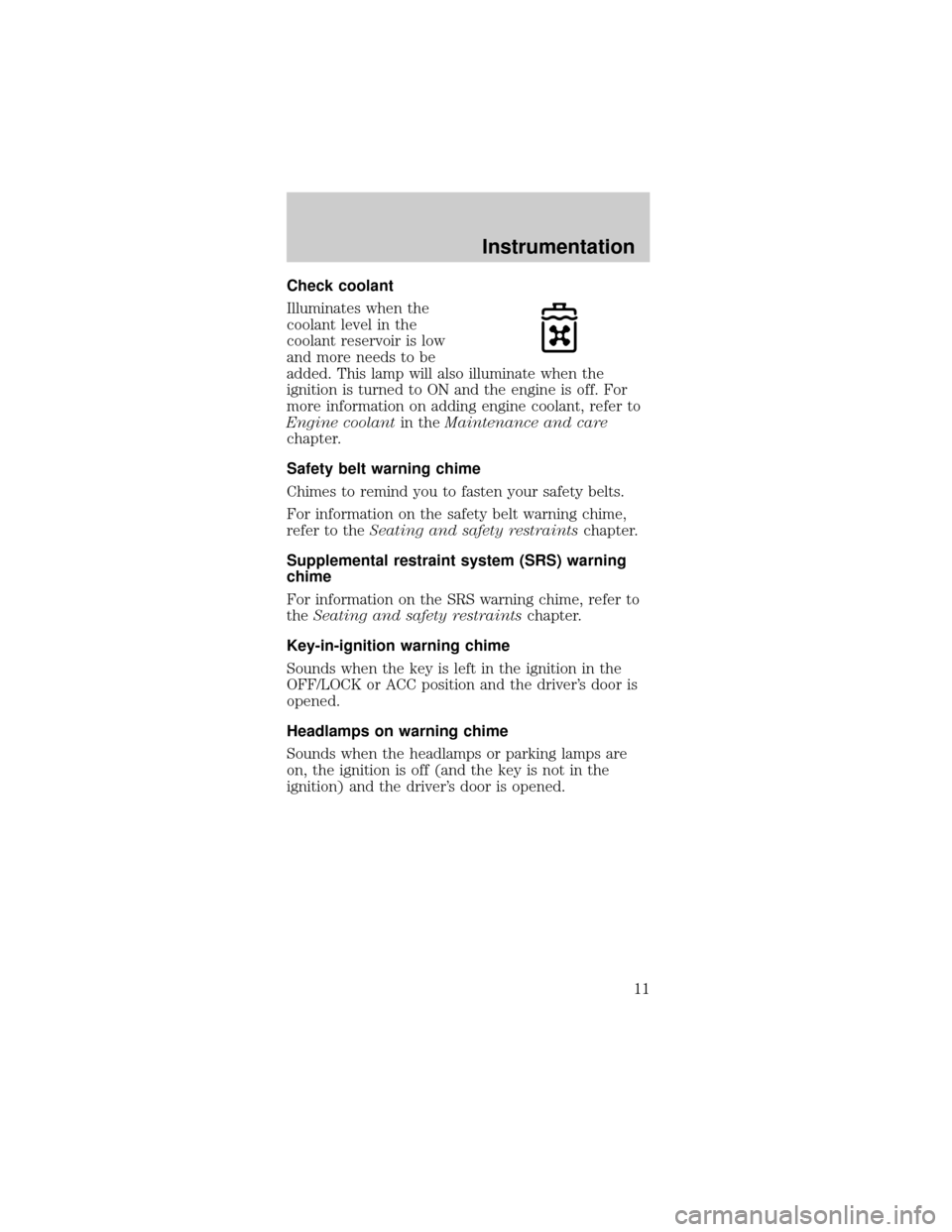
Check coolant
Illuminates when the
coolant level in the
coolant reservoir is low
and more needs to be
added. This lamp will also illuminate when the
ignition is turned to ON and the engine is off. For
more information on adding engine coolant, refer to
Engine coolantin theMaintenance and care
chapter.
Safety belt warning chime
Chimes to remind you to fasten your safety belts.
For information on the safety belt warning chime,
refer to theSeating and safety restraintschapter.
Supplemental restraint system (SRS) warning
chime
For information on the SRS warning chime, refer to
theSeating and safety restraintschapter.
Key-in-ignition warning chime
Sounds when the key is left in the ignition in the
OFF/LOCK or ACC position and the driver's door is
opened.
Headlamps on warning chime
Sounds when the headlamps or parking lamps are
on, the ignition is off (and the key is not in the
ignition) and the driver's door is opened.
Instrumentation
11
Page 13 of 192
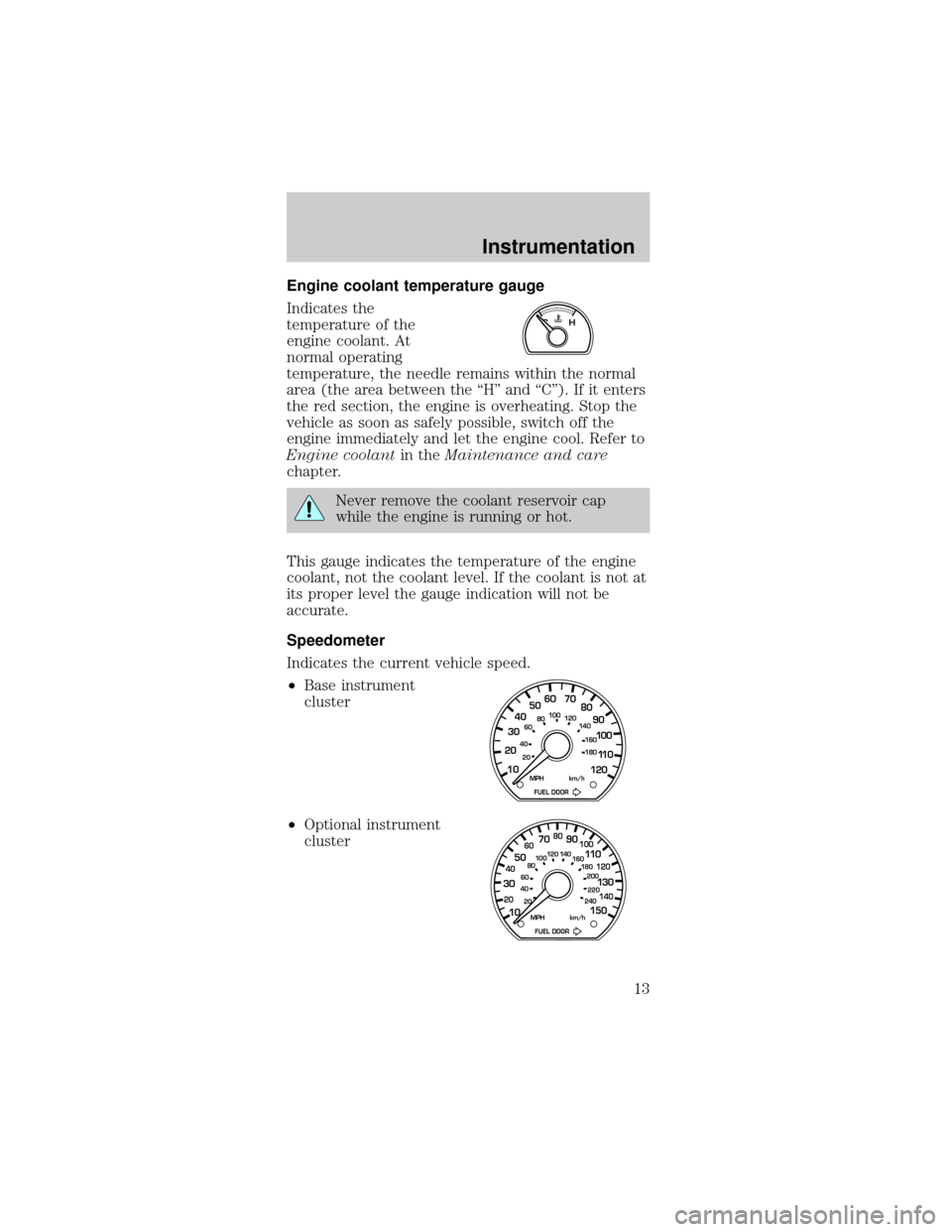
Engine coolant temperature gauge
Indicates the
temperature of the
engine coolant. At
normal operating
temperature, the needle remains within the normal
area (the area between the ªHº and ªCº). If it enters
the red section, the engine is overheating. Stop the
vehicle as soon as safely possible, switch off the
engine immediately and let the engine cool. Refer to
Engine coolantin theMaintenance and care
chapter.
Never remove the coolant reservoir cap
while the engine is running or hot.
This gauge indicates the temperature of the engine
coolant, not the coolant level. If the coolant is not at
its proper level the gauge indication will not be
accurate.
Speedometer
Indicates the current vehicle speed.
²Base instrument
cluster
²Optional instrument
cluster
CH
10 203020 406080100
120
140
160
180
405060 70
80
90
100
11 0
120
FUEL DOOR MPH km/h
102040608020 40608010 012 0 14 0
160
180
200
220
240
100
120
140
305070 90
110
13 0
150
FUEL DOOR MPH km/h
Instrumentation
13
Page 130 of 192
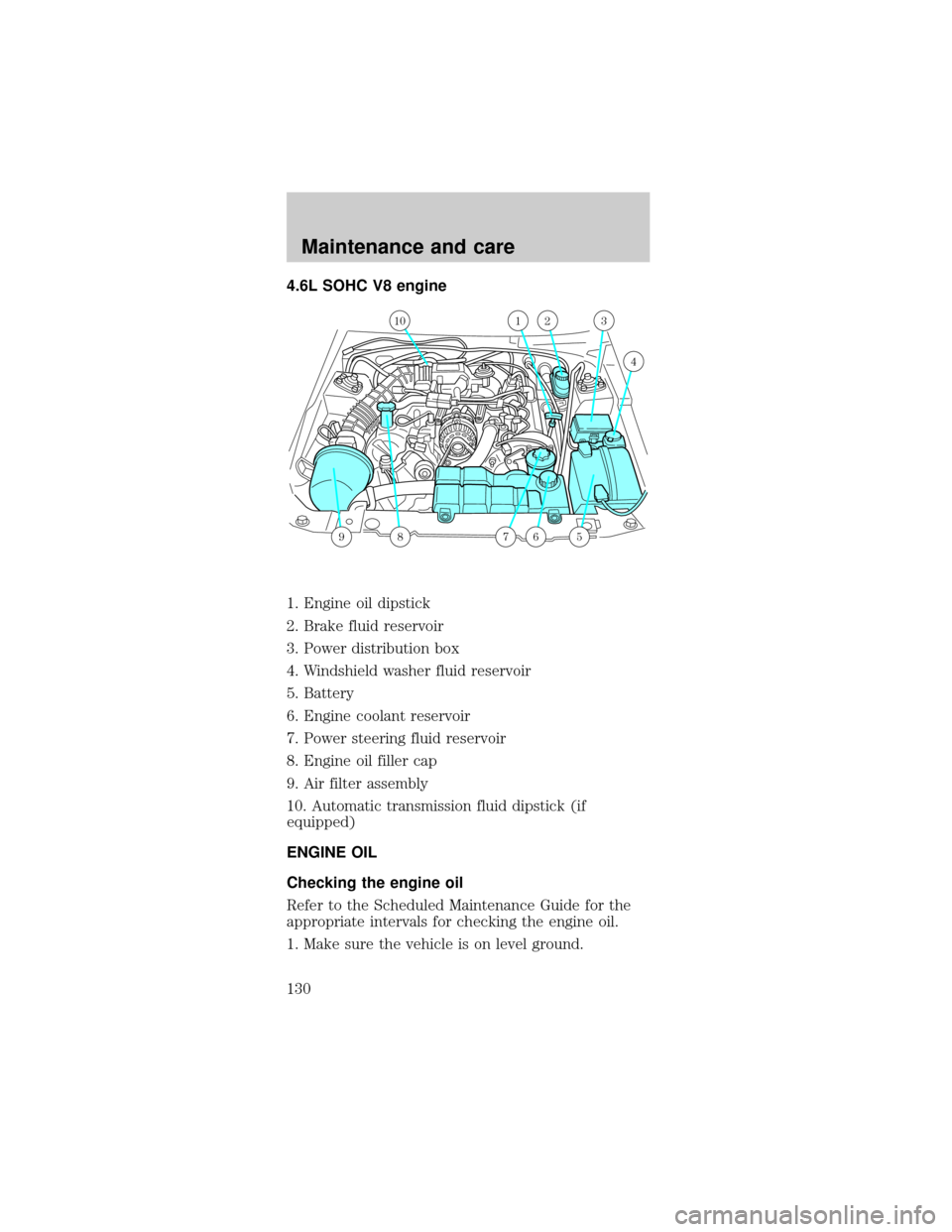
4.6L SOHC V8 engine
1. Engine oil dipstick
2. Brake fluid reservoir
3. Power distribution box
4. Windshield washer fluid reservoir
5. Battery
6. Engine coolant reservoir
7. Power steering fluid reservoir
8. Engine oil filler cap
9. Air filter assembly
10. Automatic transmission fluid dipstick (if
equipped)
ENGINE OIL
Checking the engine oil
Refer to the Scheduled Maintenance Guide for the
appropriate intervals for checking the engine oil.
1. Make sure the vehicle is on level ground.
56798
23
4
110
Maintenance and care
130
Page 136 of 192
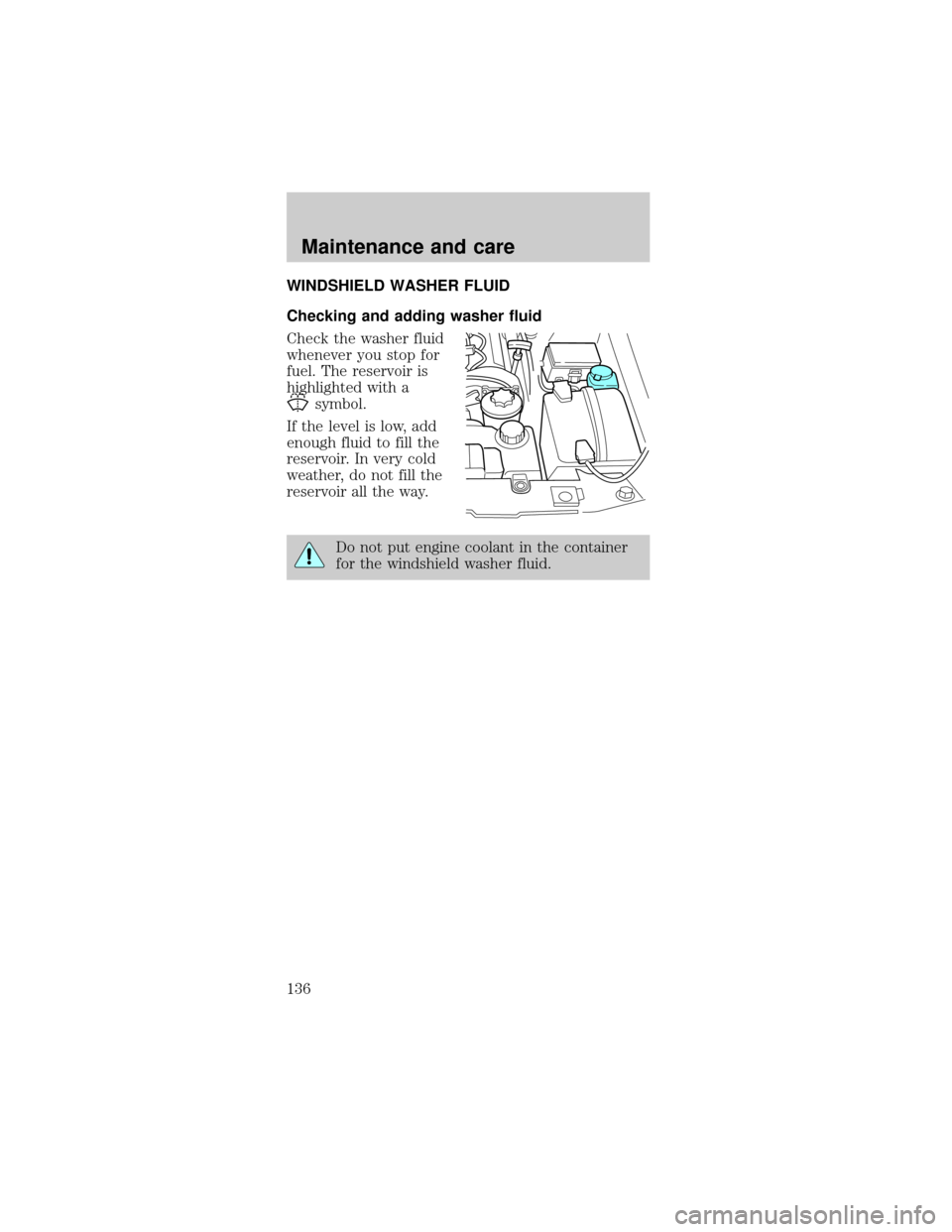
WINDSHIELD WASHER FLUID
Checking and adding washer fluid
Check the washer fluid
whenever you stop for
fuel. The reservoir is
highlighted with a
symbol.
If the level is low, add
enough fluid to fill the
reservoir. In very cold
weather, do not fill the
reservoir all the way.
Do not put engine coolant in the container
for the windshield washer fluid.
Maintenance and care
136
Page 137 of 192
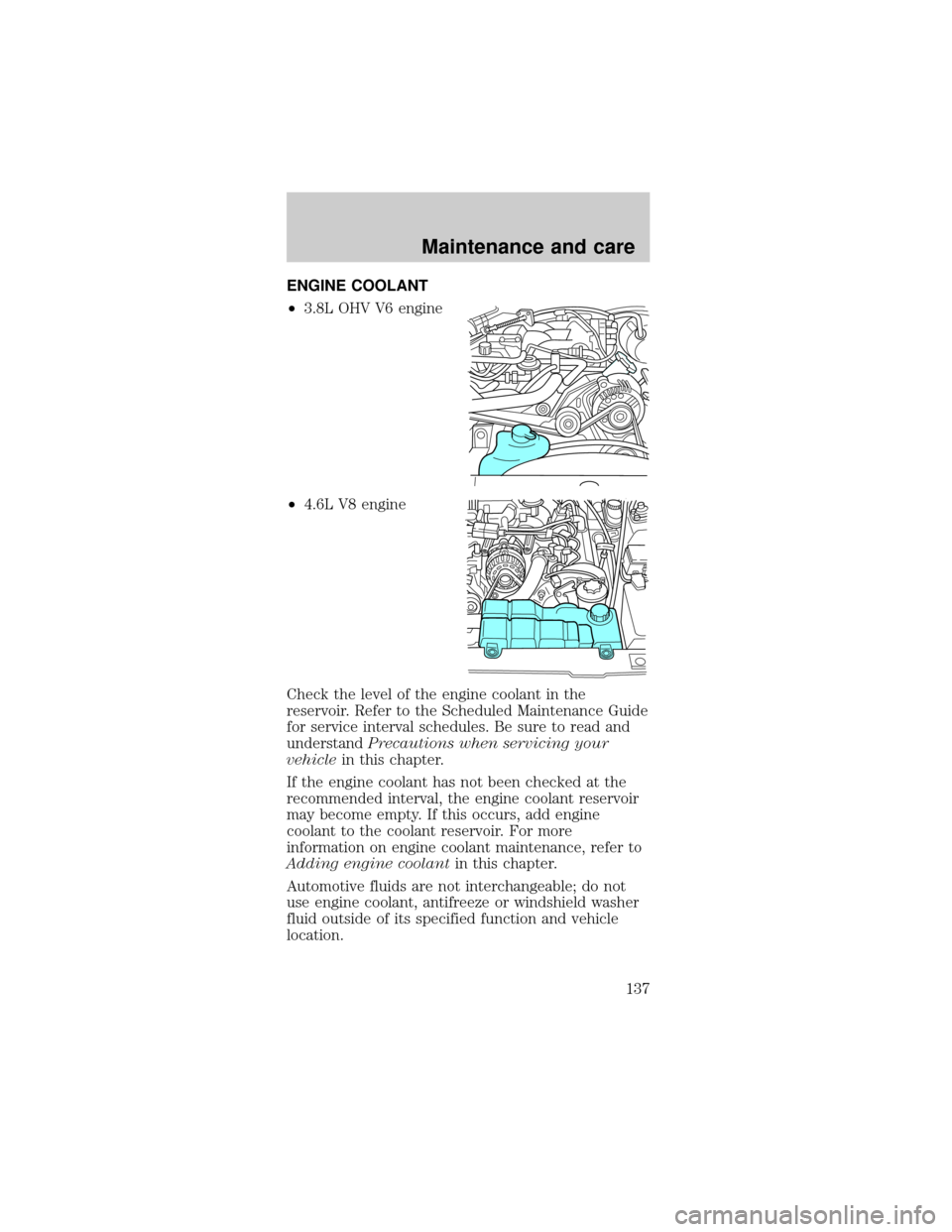
ENGINE COOLANT
²3.8L OHV V6 engine
²4.6L V8 engine
Check the level of the engine coolant in the
reservoir. Refer to the Scheduled Maintenance Guide
for service interval schedules. Be sure to read and
understandPrecautions when servicing your
vehiclein this chapter.
If the engine coolant has not been checked at the
recommended interval, the engine coolant reservoir
may become empty. If this occurs, add engine
coolant to the coolant reservoir. For more
information on engine coolant maintenance, refer to
Adding engine coolantin this chapter.
Automotive fluids are not interchangeable; do not
use engine coolant, antifreeze or windshield washer
fluid outside of its specified function and vehicle
location.
Maintenance and care
137
Page 138 of 192
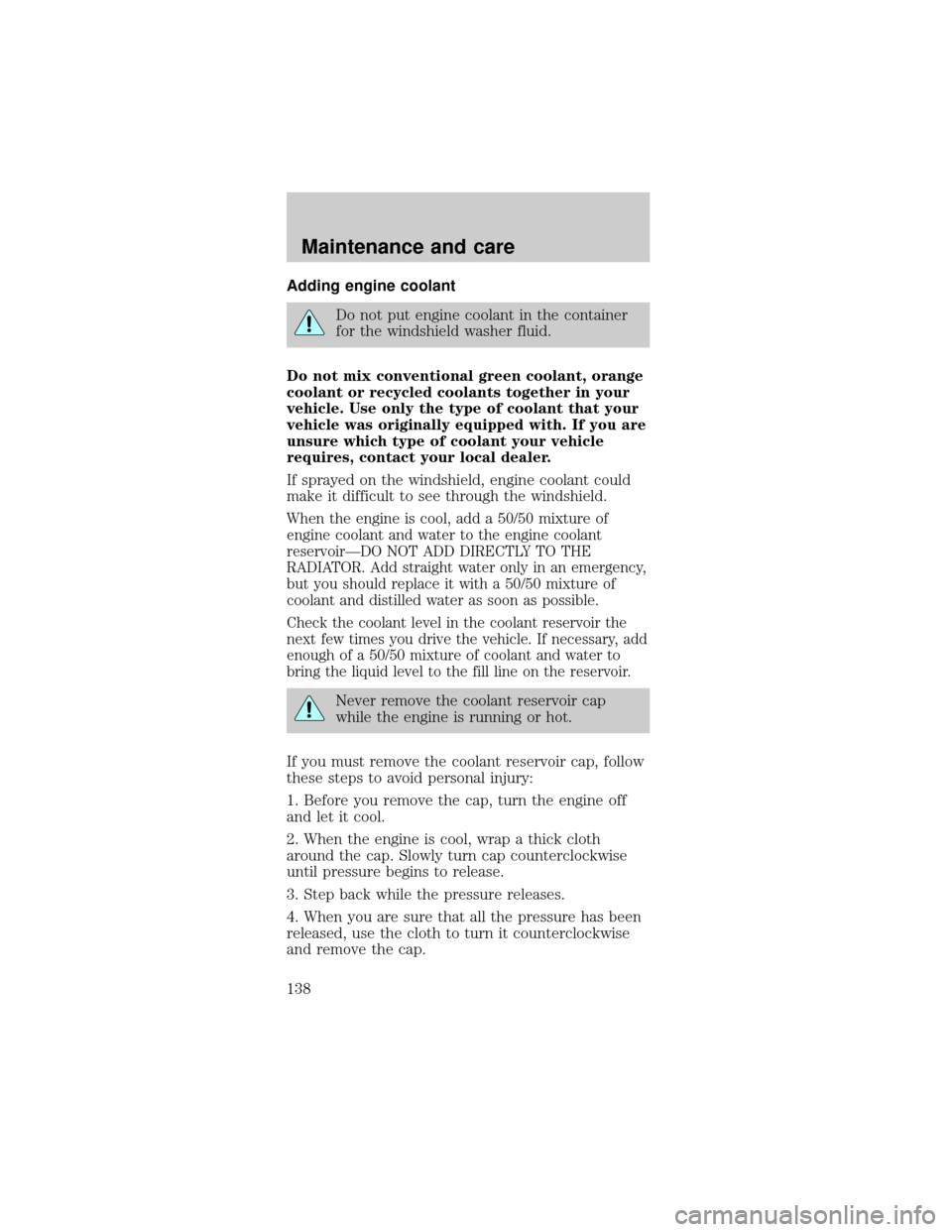
Adding engine coolant
Do not put engine coolant in the container
for the windshield washer fluid.
Do not mix conventional green coolant, orange
coolant or recycled coolants together in your
vehicle. Use only the type of coolant that your
vehicle was originally equipped with. If you are
unsure which type of coolant your vehicle
requires, contact your local dealer.
If sprayed on the windshield, engine coolant could
make it difficult to see through the windshield.
When the engine is cool, add a 50/50 mixture of
engine coolant and water to the engine coolant
reservoirÐDO NOT ADD DIRECTLY TO THE
RADIATOR. Add straight water only in an emergency,
but you should replace it with a 50/50 mixture of
coolant and distilled water as soon as possible.
Check the coolant level in the coolant reservoir the
next few times you drive the vehicle. If necessary, add
enough of a 50/50 mixture of coolant and water to
bring the liquid level to the fill line on the reservoir.
Never remove the coolant reservoir cap
while the engine is running or hot.
If you must remove the coolant reservoir cap, follow
these steps to avoid personal injury:
1. Before you remove the cap, turn the engine off
and let it cool.
2. When the engine is cool, wrap a thick cloth
around the cap. Slowly turn cap counterclockwise
until pressure begins to release.
3. Step back while the pressure releases.
4. When you are sure that all the pressure has been
released, use the cloth to turn it counterclockwise
and remove the cap.
Maintenance and care
138
Page 140 of 192
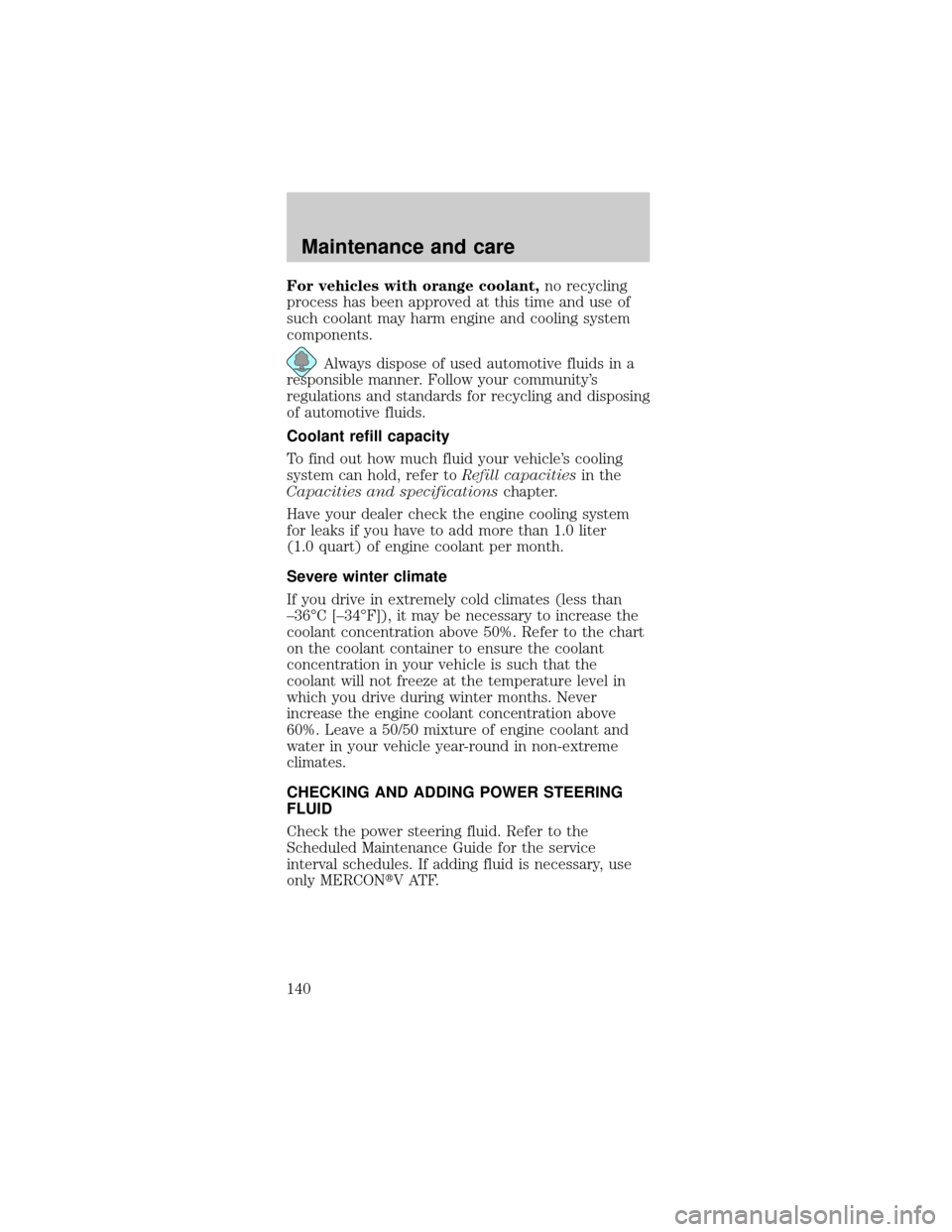
For vehicles with orange coolant,no recycling
process has been approved at this time and use of
such coolant may harm engine and cooling system
components.
Always dispose of used automotive fluids in a
responsible manner. Follow your community's
regulations and standards for recycling and disposing
of automotive fluids.
Coolant refill capacity
To find out how much fluid your vehicle's cooling
system can hold, refer toRefill capacitiesin the
Capacities and specificationschapter.
Have your dealer check the engine cooling system
for leaks if you have to add more than 1.0 liter
(1.0 quart) of engine coolant per month.
Severe winter climate
If you drive in extremely cold climates (less than
±36ÉC [±34ÉF]), it may be necessary to increase the
coolant concentration above 50%. Refer to the chart
on the coolant container to ensure the coolant
concentration in your vehicle is such that the
coolant will not freeze at the temperature level in
which you drive during winter months. Never
increase the engine coolant concentration above
60%. Leave a 50/50 mixture of engine coolant and
water in your vehicle year-round in non-extreme
climates.
CHECKING AND ADDING POWER STEERING
FLUID
Check the power steering fluid. Refer to the
Scheduled Maintenance Guide for the service
interval schedules. If adding fluid is necessary, use
only MERCONtV ATF.
Maintenance and care
140
Page 141 of 192
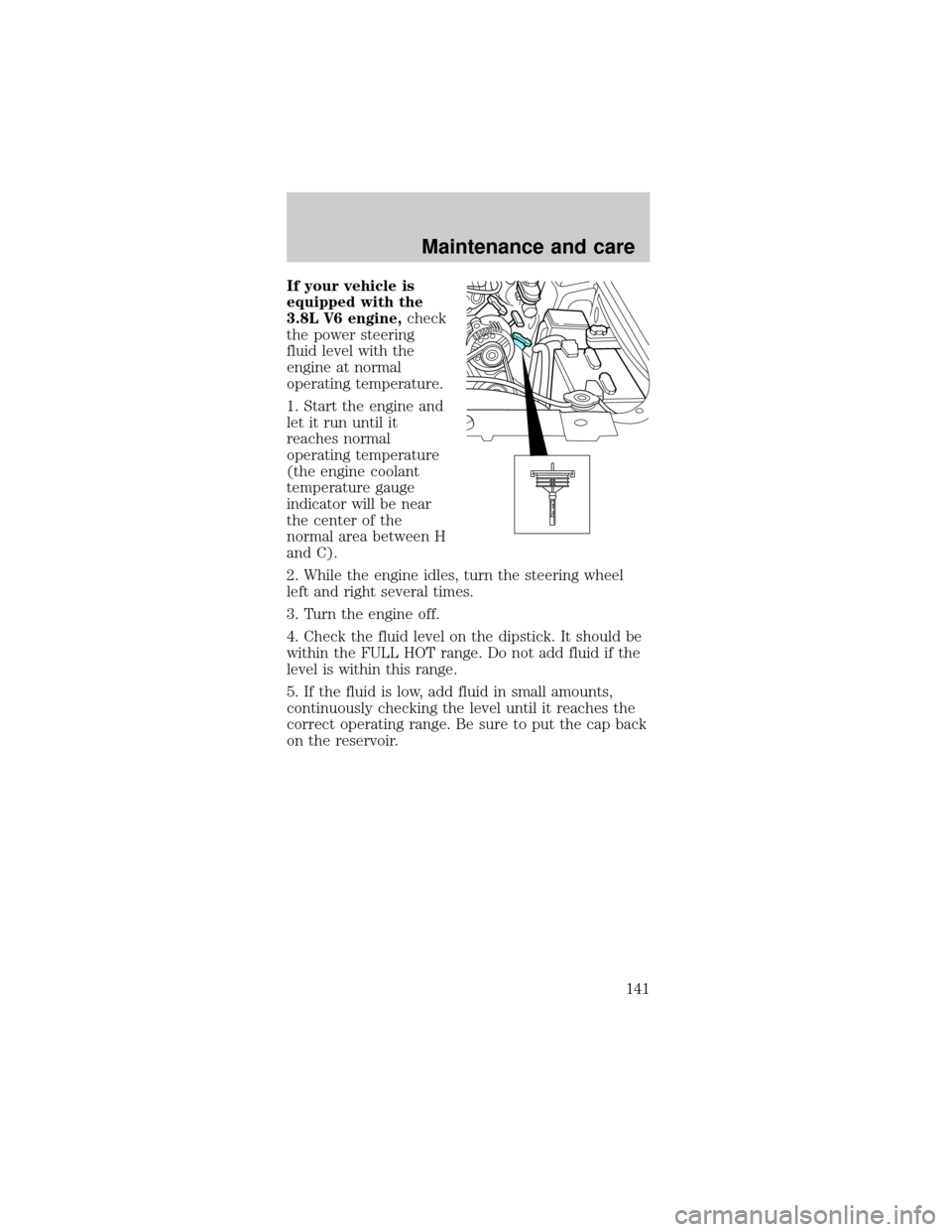
If your vehicle is
equipped with the
3.8L V6 engine,check
the power steering
fluid level with the
engine at normal
operating temperature.
1. Start the engine and
let it run until it
reaches normal
operating temperature
(the engine coolant
temperature gauge
indicator will be near
the center of the
normal area between H
and C).
2. While the engine idles, turn the steering wheel
left and right several times.
3. Turn the engine off.
4. Check the fluid level on the dipstick. It should be
within the FULL HOT range. Do not add fluid if the
level is within this range.
5. If the fluid is low, add fluid in small amounts,
continuously checking the level until it reaches the
correct operating range. Be sure to put the cap back
on the reservoir.
FILL
HOT
Maintenance and care
141
Page 179 of 192
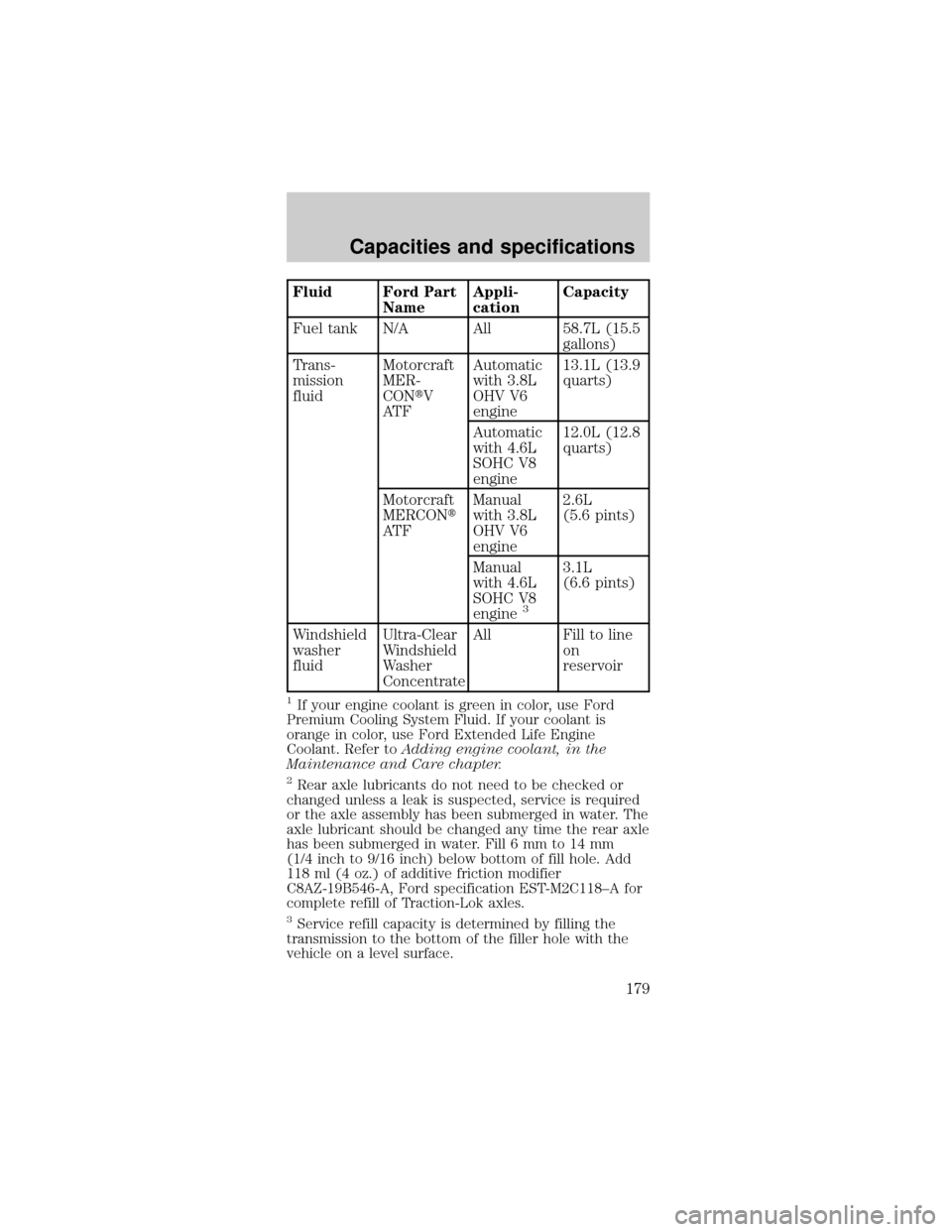
Fluid Ford Part
NameAppli-
cationCapacity
Fuel tank N/A All 58.7L (15.5
gallons)
Trans-
mission
fluidMotorcraft
MER-
CONtV
AT FAutomatic
with 3.8L
OHV V6
engine13.1L (13.9
quarts)
Automatic
with 4.6L
SOHC V8
engine12.0L (12.8
quarts)
Motorcraft
MERCONt
AT FManual
with 3.8L
OHV V6
engine2.6L
(5.6 pints)
Manual
with 4.6L
SOHC V8
engine
3
3.1L
(6.6 pints)
Windshield
washer
fluidUltra-Clear
Windshield
Washer
ConcentrateAll Fill to line
on
reservoir
1If your engine coolant is green in color, use Ford
Premium Cooling System Fluid. If your coolant is
orange in color, use Ford Extended Life Engine
Coolant. Refer toAdding engine coolant, in the
Maintenance and Care chapter.
2Rear axle lubricants do not need to be checked or
changed unless a leak is suspected, service is required
or the axle assembly has been submerged in water. The
axle lubricant should be changed any time the rear axle
has been submerged in water. Fill 6 mm to 14 mm
(1/4 inch to 9/16 inch) below bottom of fill hole. Add
118 ml (4 oz.) of additive friction modifier
C8AZ-19B546-A, Ford specification EST-M2C118±A for
complete refill of Traction-Lok axles.
3Service refill capacity is determined by filling the
transmission to the bottom of the filler hole with the
vehicle on a level surface.
Capacities and specifications
179
Page 192 of 192
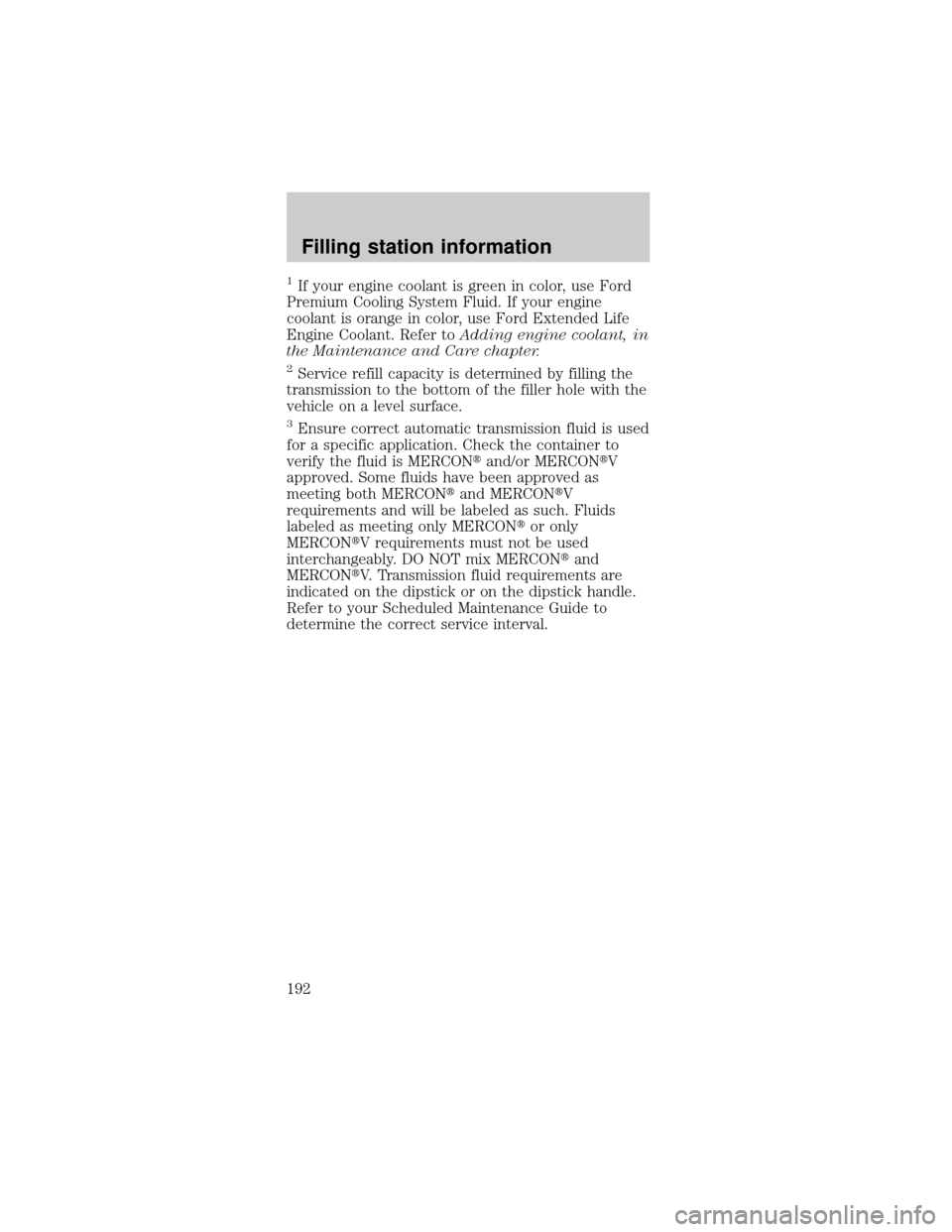
1If your engine coolant is green in color, use Ford
Premium Cooling System Fluid. If your engine
coolant is orange in color, use Ford Extended Life
Engine Coolant. Refer toAdding engine coolant, in
the Maintenance and Care chapter.
2Service refill capacity is determined by filling the
transmission to the bottom of the filler hole with the
vehicle on a level surface.
3Ensure correct automatic transmission fluid is used
for a specific application. Check the container to
verify the fluid is MERCONtand/or MERCONtV
approved. Some fluids have been approved as
meeting both MERCONtand MERCONtV
requirements and will be labeled as such. Fluids
labeled as meeting only MERCONtor only
MERCONtV requirements must not be used
interchangeably. DO NOT mix MERCONtand
MERCONtV. Transmission fluid requirements are
indicated on the dipstick or on the dipstick handle.
Refer to your Scheduled Maintenance Guide to
determine the correct service interval.
Filling station information
192